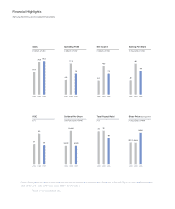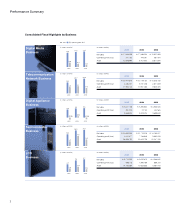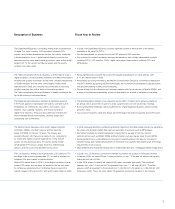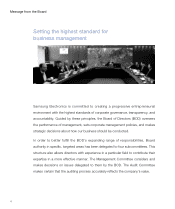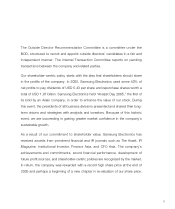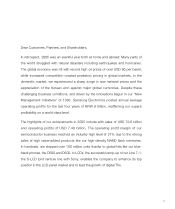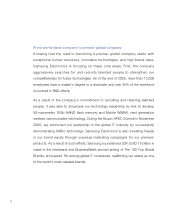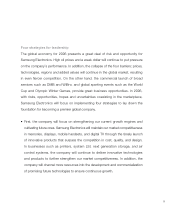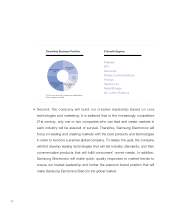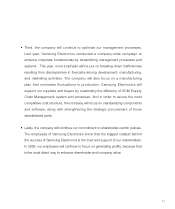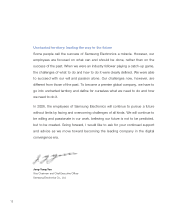Samsung 2005 Annual Report Download - page 5
Download and view the complete annual report
Please find page 5 of the 2005 Samsung annual report below. You can navigate through the pages in the report by either clicking on the pages listed below, or by using the keyword search tool below to find specific information within the annual report.
• The global appliance market is now valued at around USD 170 billion and is growing steadily at
an annual rate of around 3% in spite of a sharp surge in prices for both oil and raw materials.
• Surmounting these challenges, Samsung Electronics’ Digital Appliance Business showed steady
growth in 2005.
• Our product innovations, high-end design, and technology have been recognized around the world.
3
Description of Business Fiscal Year in Review
• In 2005, the Digital Media Business showed significant growth in the high end of the market,
especially in flat panel TV (FPTV).
• We also transitioned our product focus from DVD players to DVD recorders.
• We continued to expand our laptop sales and increased our ratio of high-value-added products,
including FPTVs, LCD monitors, DVDs, digital camcorders, laser printers, notebook PCs, and
MP3 players.
The Digital Media Business is a leading developer and manufacturer
of digital TVs, color monitors, DVD recorders, notebook PCs,
printers, and portable entertainment devices. Its industry leadership
is demonstrated by its no.1 global market share in monitors and
televisions and its many award-winning products, such as the world’s
largest LCD TV, the world’s first Blu-ray player, and the world’s
smallest color laser printer.
The Digital Appliance Business maintains a significant presence
in the home appliance marketplace with side-by-side and built-in
refrigerators, air conditioners, air purifiers, microwaves, robot
cleaners, drum washing machines, and remote controlled
digital home networks. These products offer best of breed and
environmentally friendly technologies, stunning design, and
outstanding user convenience.
• In 2005, Samsung Electronics achieved yet another milestone in the data storage industry by expanding
the scope of high density NAND flash memory application to products such as MP3 players.
• We further bolstered our market leadership by being the top supplier of not only memory
semiconductors such as DRAM, SRAM and flash memory but also display driver ICs and MCPs.
• Samsung Electronics is strengthening its long-term competitiveness in this area by focusing on
nanotechnology and market sensing efforts to introduce new solutions that enable future technology
requirements in set products.
• Major achievements include the development of 16Gb NAND flash and 7.2 Megapixel CMOS image sensor.
The Semiconductor Business is the world’s largest producer
of DRAMs, SRAMs, and flash memory and has been the
leader in DRAMs for the past 14 years. The division also
pioneered System LSI chips and a variety of core components
for mobile and digital consumer applications. These include
system-on-chip (SOC) products, the world’s fastest mobile
AP (Application Processor), display driver ICs, CMOS image
sensors, and the world’s first 52X RW Combo Drive.
• In 2005, our LCD Business continued to maintain its number one position in total sales revenue.
• In January 2006, we started Phase 1 mass production on our 7-2 line and will achieve full capacity
during the first half of 2006.
• In late 2006, phase 2 capacity will reach 90,000 glass substrates per month. The combined
capacity from Line 7-2 and our first 7th generation line, Line 7-1, will total 180,000 7G mother
glasses, which is equivalent to the production of 1,440,000 40" LCD panels or 1,080,000 46" LCD
panels per month. This is the most stable 7th generation production capability in the industry.
The LCD Business develops and manufactures LCD panels for TVs
and large-scale monitors (greater than 10˝ ), as well as displays for
notebook PCs and a variety of mobile devices.
With a 20% market share in 2005, it is the largest producer of large-
screen LCD panels and has been the leader for the last four years.
Its continuous advancements in technology have produced the
market’s largest LCDs since 2001, with an 82˝ panel offered in 2005.
The Telecommunication Network Business is at the heart of today’s
digital revolution, providing wireless handsets and telecommunication
infrastructure systems worldwide. As the world’s largest manufacturer
of CDMA handsets and the world’s third largest mobile phone
manufacturer in 2005, the company has contributed to improving
people’s everyday lives with a series of innovative products.
The Telecommunication Network Business is steadily climbing to the
top as the industry’s innovative leader.
• Samsung Electronics became the world’s third largest manufacturer of mobile phones, with
a 12.6% market share in 2005.
• Anticipating upcoming innovations, the Mobile Communication Division is committed to leading the
mobile TV market, supporting HSDPA technologies, and continuing to strengthen its global position
with ground-breaking mobiles and 3G handsets.
• We are driving both the domestic and overseas markets with the introduction of Mobile WiMAX, and
a range of sophisticated networking systems in preparation for a world of ubiquitous computing.



